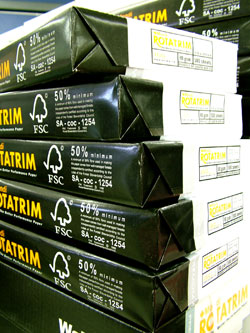Archive for April, 2009
Green up your IT
There’s a lot of talk about green IT, and most of it out there is just a glorified marketing pitch. One thing we all need to keep in mind, is that manufacturing new equipment, whether green or not, is much more wasteful than keeping existing equipment going (with a few exceptions).
Let’s face it, as a business owner most of us would love to have a green IT, but most of us aren’t willing to sacrifice performance or cost, at the expense of being green. Buying a $75 power strip that saves $3.00 per year in energy costs, isn’t a smart buy, no matter how many magazines say it is so.
Forget ROHS, Energy Star, and everything else. Here’s how to green up your IT…
1.) Buy used equipment
 When you need to buy computer equipment, try to look for used or refurbished equipment before buying new.
When you need to buy computer equipment, try to look for used or refurbished equipment before buying new.
New computers and IT equipment are generally much less power consuming than older equipment. However, buying used equipment reduces the load on landfills and reduces the emissions and waste from manufacturing more equipment.
The best way to reduce waste is to not create more!
You probably won’t find any computer manufacturer recommending this any time soon, because they want you to shell out for new (& more expensive) equipment. Manufacturers have been making efficient equipment for at least five years. You can find plenty of great IT equipment on eBay for a fraction of the cost of new.
If you still have some old mainframe computer using up a megawatt of electricity per month, it may be time to upgrade…
2.) When buying any equipment, buy what you need, not what you want
 The thing about those personal super computers with forty processors, quad-graphics cards, and 200 gigabytes of RAM, is that they require a lot of power to run.
The thing about those personal super computers with forty processors, quad-graphics cards, and 200 gigabytes of RAM, is that they require a lot of power to run.
Most of the time, you don’t need high-end equipment for running Office and an email program. Get the most minimal computers and equipment that you can get by with, also calculating for future usage so you don’t need to upgrade.
Video cards are one of the most effective places to downgrade. You don’t need a monster graphics card to view 2D text and pictures. A puny 16Mb card can do this fine. Skip the SLI, Crossfire, 512 MB DDR3 cards and get something small and efficient.
3.) Consolidate equipment
A server for email, a server for files, a server for the database, a server for the website, a server for backups, etc…
This is the all-too-common setup that I see businesses use. While there’s a point to segmenting for security and operational independence, many times these servers can be consolidated into a few. It also costs more to manage and maintain multiple servers and computers, so reducing the total number is appealing on multiple fronts.
One or two very good servers is usually cheaper to maintain and more energy efficient than five mediocre servers. Using virtualization, you can often get all of your servers running securely on a single machine.
For a small business, I personally like to put the web, intranet and email servers all on a single machine, and then the internal file server, domain controller, and internal application server on a separate machine. This provides good segmentation, and is easy to manage and understand.
4.) Buy UPS (uninterruptible power supply / battery backup) devices for your equipment
for your equipment
The best surge protector is rarely as good as a cheap UPS device. These will protect your equipment from surges, and shut them down if there is a loss power. Keeping equipment out of the trash is the best way to stay green.
Power outages kill computer equipment, especially servers, even if there isn’t a surge that goes with it. You can buy UPS devices used, and replace the batteries when they get exhausted. They can save thousands on IT costs and troubleshooting from losing equipment. APC is probably the leader in UPS devices. Just make sure that you can replace the batteries before buying one.
Don’t even consider operating good computer equipment without a decent UPS to go with it. These will truly save money and time in the long run.
5.) Stop the paper
 We all have email, and there are hundreds of scanners that can put paper into a usable PDF or text document. At this point, there is very little reason not to stop using paper. Legal documents are one thing, but for everything else, print it to a PDF, and email it.
We all have email, and there are hundreds of scanners that can put paper into a usable PDF or text document. At this point, there is very little reason not to stop using paper. Legal documents are one thing, but for everything else, print it to a PDF, and email it.
You can save your business thousands per year in paper and ink costs by converting to electronic documents.
At one point we were using over 60,000 pages per month just in personal printing. After switching to scanning and PDF printing, it was reduced to under 5,000.
You will have some employees fighting this to the death, but in the end there is no doubt that it is worth the time and effort to get everyone using electronic only documents.